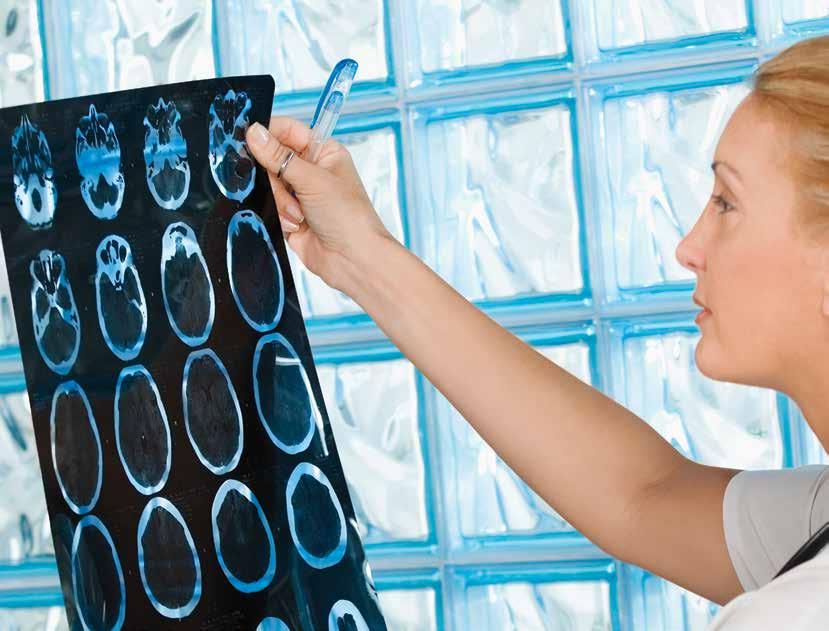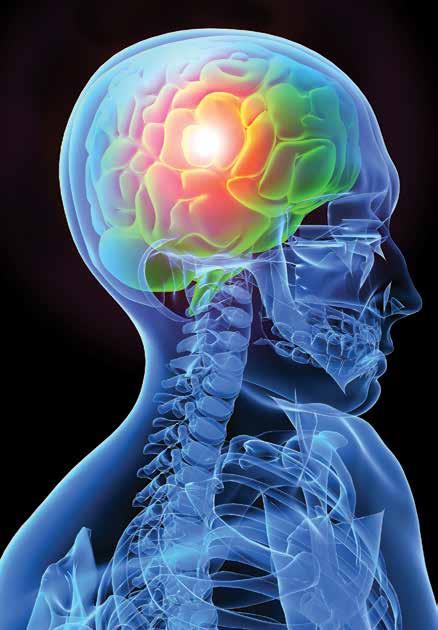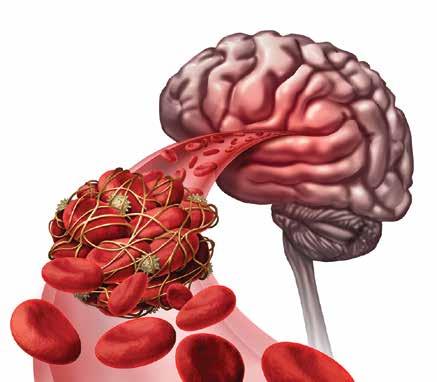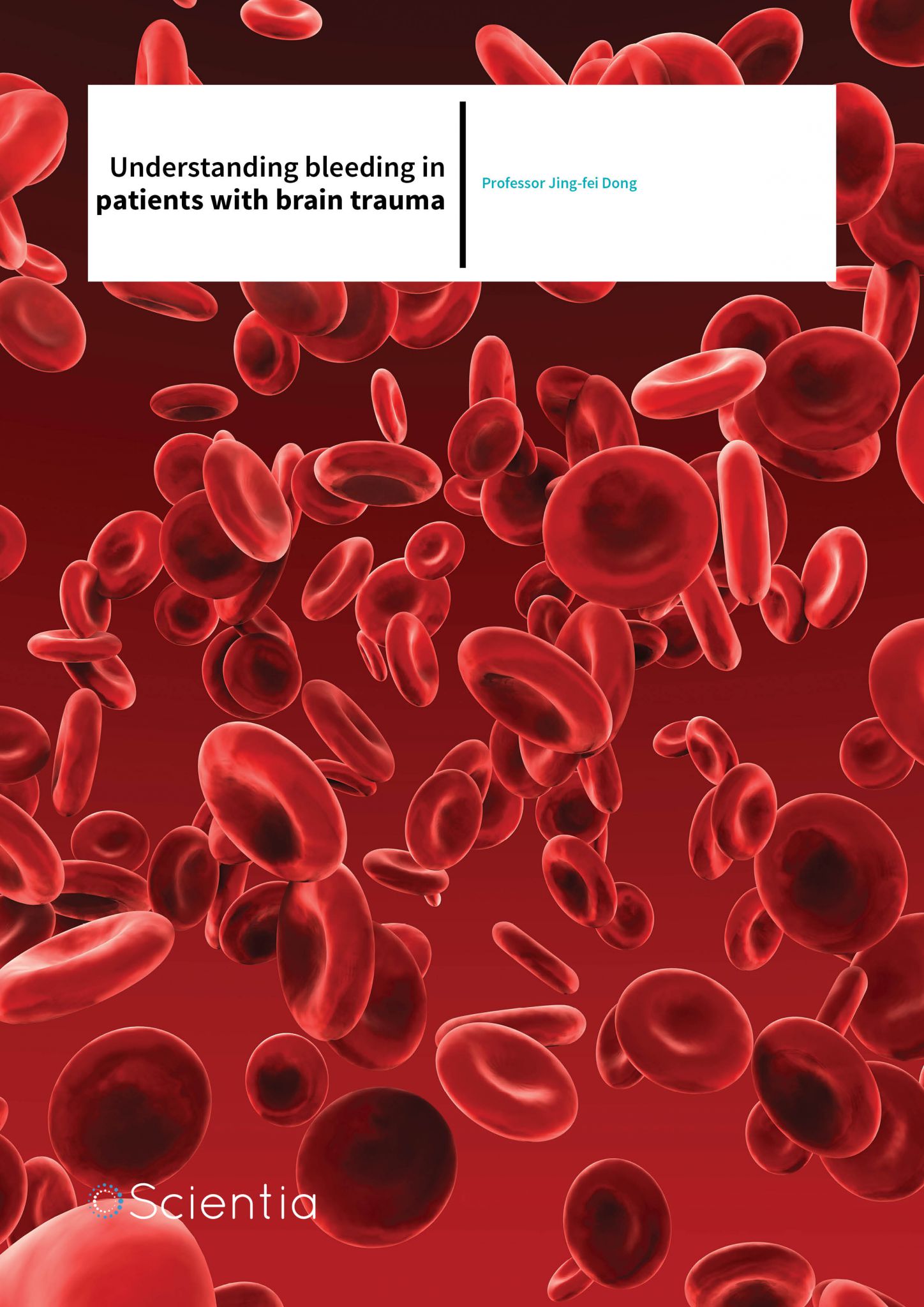Professor Jing-Fei Dong – Understanding Bleeding In Patients With Brain Trauma
Professor Jing-fei Dong of Bloodworks Research Institute and the University of Washington and Tianjin Medical University, studies the effect that traumatic brain injuries can have on the ability of the blood to form blood clots to control for trauma-induced bleeding. Patients with traumatic brain injury can present with a condition called coagulopathy, in which they cannot form blood clots effectively, leading to uncontrolled bleeding. Professor Dong’s research aims to uncover the mechanism underlying brain trauma associated coagulopathy, with the eventual goal of discovering new biomarkers and designing new therapies for this condition that is often fatal.

Coagulation – an essential process after traumatic injury
Blood clotting, also known as coagulation, is the process by which liquid blood forms a semi-solid or gel-like bolus. This clot functions to stop liquid blood loss from damaged blood vessels, which is a mechanism known as hemostasis. Coagulation is a multifactorial process and is initiated when blood is exposed to tissue underlying the lining of blood vessels. This can occur following blood vessel damage due to trauma, for example. One of the first steps in coagulation is the binding of very small cells known as platelets in blood to the site of injury. The platelets form an initial plug at the site of injury. A complex biochemical cascade subsequently occurs that involves the activation of the platelets, which go on to release a cocktail of substances that are procoagulatory. A host of factors sequentially participate in the coagulation reaction. The final outcome is the conversion of fibrinogen, a soluble protein present in blood plasma, to fibrin, which forms at the injury site as sticky threads. The fibrin threads form a sticky mesh, which traps platelets, other blood cells and plasma proteins to make a clot to seal the vascular wound. Finally, the fibrin meshwork contracts, squeezing the liquid in the clot out and helping to make the clot more solid.
Coagulation is particularly important in cases of traumatic injury. Extensive damage to blood vessels during trauma can result in rapid blood loss, through both internal or external bleeding, which can be life threatening. In fact, uncontrolled bleeding causes 30–40% of trauma fatalities. Consequently, it is important that effective coagulatory processes can operate to slow blood loss as rapidly as possible. Trauma is a major cause of death among all adults and is the leading cause of death among younger people (45 years old and younger). Coagulopathy is a major reason underlying uncontrolled bleeding in trauma injuries.
Coagulopathy – when blood clotting fails
Coagulopathy is a condition in which the blood is not able to form clots effectively, leading to uncontrolled bleeding. Coagulopathy can occur for a variety of reasons. In trauma patients, coagulopathy can occur as a result of blood loss, blood dilution because of saline transfusions to maintain blood pressure, and dysfunction of components of the coagulatory system itself. Coagulopathy also contributes to, and is enhanced by, low body temperature, and blood becoming metabolically acidic (acidosis). In fact, seriously injured trauma patients can experience what is known as the ‘death triad’ of coagulopathy, hypothermia and blood acidosis, where a vicious cycle of these processes is self-perpetuating and difficult to treat, ultimately resulting in death. Professor Dong tells Scientia about the current clinical situation and lack of new therapies: ‘Doctors are left with very limited treatment options, especially compared with the recent rapid advances in the diagnosis and treatment of cancer, heart attack and stroke.’ Therefore, it is imperative to find effective ways to rapidly diagnose and treat coagulopathy.
Coagulopathy as a result of brain trauma
The brain is a particularly serious location to obtain a traumatic injury. Traumatic brain injuries are a significant source of disability and death. Professor Dong explains the scale of the problem and the major sources of traumatic brain injury: ‘While it has often been associated with wars in a historical context, traumatic brain injury has increasingly been linked to modern society as it is often caused by road traffic accidents, construction accidents, sport injuries and violence. In 2013 alone, about 2.5 million emergency department visits, hospitalizations, and deaths in the United States were associated with traumatic brain injury, either alone or as a part of polytrauma that also involves the trunk and limbs. More importantly, patients with traumatic brain injury have very high rates of mortality and morbidity. However, the pathogenesis of traumatic brain injury and its complications remain poorly understood.’
Patients who suffer traumatic injuries of the brain also commonly suffer coagulopathy, which can complicate their recovery and increase their chances of death. Incidences of coagulopathy are reported to vary from 10–97% in such patients. However, interestingly, the major risk factors for coagulopathy in traumas of the trunk and limbs, namely, significant blood loss and blood dilution as a result of saline transfusions, are not typically present in patients with isolated brain trauma. Injuries of the brain produce significantly less blood loss, and fluid transfusions are often restricted to prevent brain swelling. However, brain trauma patients can go on to develop coagulopathy nevertheless, suggesting that the pathogenesis of brain injury-derived coagulopathy and that caused by injuries of the limbs and trunk are different. The mechanism of traumatic brain injury in producing coagulopathy remains incompletely understood and this is what drives the research of Professor Dong. ‘Our research could provide new insights into the pathogenesis of coagulation and other complications secondary to traumatic brain injury and lead to new and targeted therapeutics that can improve the survival of patients and their quality of life,’ he explains. The lack of mechanistic insight into this traumatic brain injury-derived coagulopathy has prevented early detection, prevention and effective treatment to date.

‘Our research could provide new insights into the pathogenesis of coagulation and other complications secondary to traumatic brain injury and lead to new and targeted therapeutics that can improve the survival of patients and their quality of life’
The basis for brain trauma-induced coagulopathy
Professor Dong’s work has focused on the biochemical factors involved in coagulation and how they relate to brain trauma. Several of these molecules are highly expressed in cells of the brain. These include plateletactivating factor, tissue factor and anionic phospholipids. When brain tissue is injured through trauma, the blood-brain barrier (a specialized form of tissue lining the blood vessels of the brain) is compromised and brain tissue components can be released into systemic circulation. These procoagulatory molecules can then initiate diffuse coagulation elsewhere in the body. As a result, platelets and coagulation factors are used up, leading to a deficit in the areas they are needed and potentially resulting in localised defects in hemostasis at the areas of vascular injury. This is known as consumptive coagulopathy. In particular, Professor Dong is interested in how these factors are released from the cerebral tissue, how they travel about the body and how they cause coagulation by interacting with other biochemical factors in the blood.
Cellular microparticles
Cellular microparticles are small (under 1 μm in size) cell fragments, composed of cell membrane and cellular organelles, that are shed and released by cells undergoing programmed cell death (this process is called apoptosis) or cells undergoing a process called microvesiculation. Such cellular microparticles are rich in signalling molecules that can affect coagulation. Professor Dong and his team hypothesised that brain-derived cellular microparticles may be a key mediator of systemic clotting abnormalities under conditions of brain trauma. The team thought, that through their release into systemic circulation and interaction with coagulation factors in plasma, brain-derived microparticles could produce consumptive coagulopathy.
Key results to date
In 2015, the team showed that producing traumatic brain injuries in mice resulted in the systemic release of brain-derived cellular membrane microparticles that expressed pro-coagulatory molecules such as tissue factor on their surfaces. The microparticles were responsible for coagulation abnormalities present after brain trauma. This finding comprised a novel mechanism for brain trauma-induced coagulopathy.
In addition to membrane-derived microparticles, more recently the team have discovered organelle-derived cerebral microparticles that are released into the systemic circulation of mice following brain trauma. Specifically, they found mitochondrial microparticles in the systemic circulation of such mice. The mitochondrion is a cellular organelle primarily involved in energy production in intact cells. The team found that a phospholipid called cardiolipin on the surface of the mitochondrial microparticles was responsible for producing systemic coagulation in the mice. In addition, they found that the mitochondria present in such microparticles produce reactive oxygen species, which cause the activation of platelets and also act as a source of oxidative stress, causing inflammation.
With the exciting discovery of this mechanism of brain trauma derived coagulopathy, the team hope that the microparticles and signalling molecules they have identified could be used as biomarkers and potential drug targets in the treatment of coagulopathy. In the short term, they plan to see if the removal of cellular microparticles from systemic circulation can ameliorate the colagulopathy associated with brain trauma.
 Motivation and future outlook
Motivation and future outlook
Professor Dong shared with us what initially interested him in this type of research: ‘My medical training is in neurosurgery and I had practiced it for 10 years, with strong clinical and research interests in traumatic brain injury. As a neurosurgeon, I have encountered numerous cases where coagulation abnormalities, not traumatic brain injury, claimed patients’ lives so I am fully aware of this severe complication of traumatic brain injury and its impact on patients’ recovery. This bleeding problem in part contributed to my desire to study platelets and adhesion molecules for thrombotic and bleeding disorders at the Gladestone Research Institute of Cardiovascular Disease, University of California at San Francisco.’ Professor Dong also explains what makes this research interdisciplinary and unique: ‘While studying hemostasis was intended to be a short-term training experience and a side project, it somehow evolved into a full-time research career in hemostasis and thrombosis. I am, therefore, in a unique position to study traumatic brain injury-associated bleeding abnormalities because of my training in two seemingly very different medical specialties: neurosurgery and hemostasis.’
The team hope to apply what they have learnt so far to discover even more about brain trauma-induced coagulopathy with the goal of developing therapies and finding new biomarkers. ‘Using knowledge that we have gained so far, we are actively investigating the contributions of other brain-derived molecules to the pathogenesis of traumatic brain injury-associated clotting deficiency.’ Professor Dong summarises. ‘We are also conducting several state-of-art experiments to identify new markers to predict the development of the clotting abnormalities found in patients with traumatic brain injury. The biomarker development will also help us develop new and targeted therapeutics that can significantly improve the outcomes of patients who suffer from traumatic injury and associated coagulopathy.’
Meet the researcher

Professor Jing-fei Dong
BloodWorks Research Institute
Division of Hematology, Department of Medicine
University of Washington, Seattle, WA, USA
Professor Jing-fei Dong is a Professor of Medicine in the Division of Hematology in the Department of Medicine at the University of Washington and is an Adjunct Professor at Tianjin Medical University and at the Section of Cardiovascular Sciences in the Department of Medicine at the Baylor College of Medicine. He has expertise in neurosurgery and hemostasis, with a particular focus on clotting disorders under conditions of traumatic brain injury. He is involved in the search for new biomarkers and therapies for brain traumainduced coagulopathy. He is the recipient of an award for Excellence in Research, from Baylor College of Medicine and an Established Investigator Award from the American Heart Association This project has received funding from the National Institute of Health in the U.S. and the Nature Science Foundation in China.
CONTACT
T: (+1) 206 568 2188
W: http://www.bloodworksnw.org/research/dong.htm
KEY COLLABORATORS
Dr Fangyi Zhang, Department of Neurosurgery, Harborview Medical Center, University of Washington
Dr Randall M. Chesnut, Department of Neurosurgery, Harborview Medical Center, University of Washingto
Dr Jianning Zhang, Department of Neurosurgery, Tianjin Medical University General Hospital
Dr Min Li, Institute of Pathology, School of Basic Medical Sciences, Lanzhou University.
FUNDING
The research is funded by Research funds of BloodWorks Research Institute, the National institute of Neurological Disorders and Stroke and National Heart, Lungs, and Blood Institute, National Institute of Health, US, and Natural Science Foundation grants and Chinese Scholarship funds, China
REFERENCES
Z Zhao, M Wang, Y Tian, T Hilton, B Salsbery, EZ Zhou, X Wu, P Thiagarajan, E Boilard, M Li, J Zhang and J-f Dong, Cardiolipinmediated procoagulant activity of mitochondria contributes to traumatic brain injury–associated coagulopathy in mice, BLOOD, 2016, 127, 2763.
Y Tian, B Salsbery, M Wang, H Yuan, J Yang, Z Zhao, X Wu, Y Zhang, BA Konkle, P Thiagarajan, M Li, J Zhang and J-f Dong, Brain-derived microparticles induce systemic coagulation in a murine model of traumatic brain injury, Blood, 2015, 125, 2151.
J Zhang, R Jiang, L Liu, T Watkins, F Zhang and J-f Dong, Traumatic Brain Injury-Associated Coagulopathy, Journal of Neurotrauma, 2012, 29, 2597–2605.
X Huang, Y Zhang, S Li, S Li, Q Tang, Z Wang, JF Dong and JN Zhang, Intracerebroventricular Transplantation of ex vivo Expanded Endothelial Colony-Forming Cells Restores Blood Brain Barrier Integrity and Promotes Angiogenesis of Mice with Traumatic Brain Injury, J. Neurotrauma., 2013, 30, 2080–2088.
L Liu, H Wei, F Chen, J Wang, JF Dong and J Zhang, Endothelial progenitor cells correlate with clinical outcome of traumatic brain injury, Critical Care Medicine, 2011, 39, 1760–1765.
L Liu, H Liu, J Jao, H Liu, A Bergeron, JF Dong and JN Zhang, Changes in circulating human endothelial progenitor cells after brain injury, J Neurotrauma, 2007, 24, 936–943.

